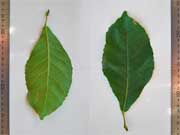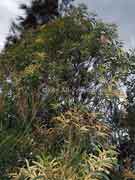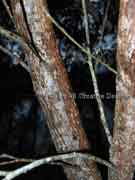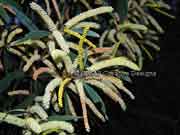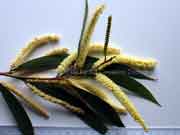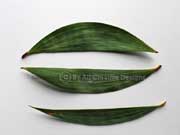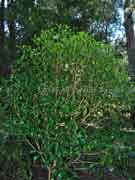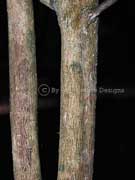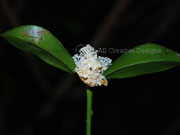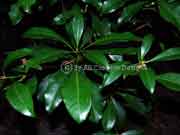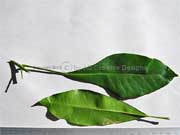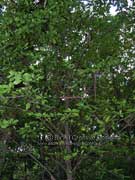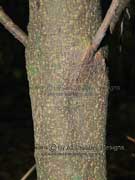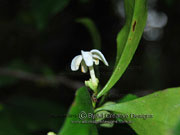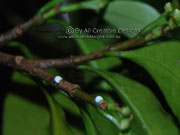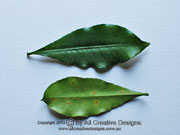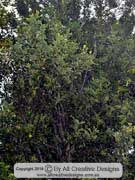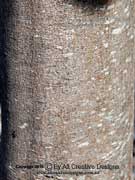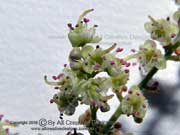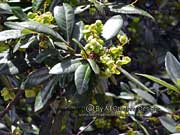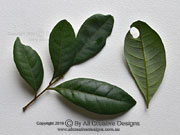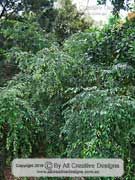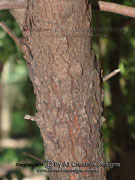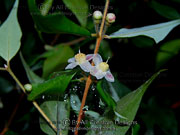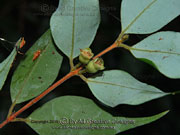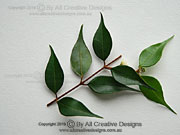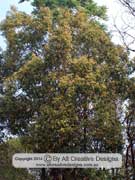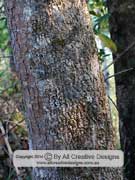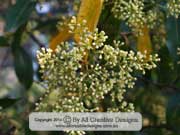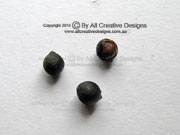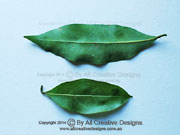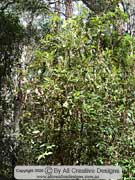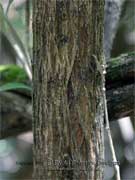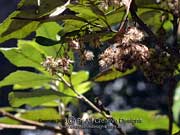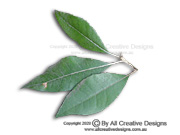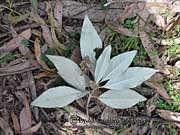
< Expand the Menu to access our Tree Identification Pages
Identify Australian Rainforest Tree Species
Identify more than 440 Australian trees and shrubs using descriptions and enlarged images of full tree, bark, leaf, fruit and/or flower samples. The Key to Species refers to native trees & shrubs listed on the Trees of Australia's East Coast Web Pages. Detailed information on leaf features, bark texture and distribution range are given for each native tree species. The Rainforest of Australia's East Coast book shows tree identification images in printed format.
The content of the web page below is constantly extended, revised and updated. Refresh the page in your browser to view updated content. We aim to build up the awareness to the high conservation values of Australian old growth forests. Species in the following genera are listed in groups on our web pages: Australian Fig trees (Ficus spp.) Page 5, Australian Eucalypts (Eucalyptus spp.) Page 4, Grevilleas (Grevillea spp.) Page 6 and Syzygium species (Lilly Pillies) Page 10. Otherwise all native Australian tree species are listed by common name in alphabetical order.
Hairpin Banksia Banksia spinulosa
Hairpin Banksia Banksia spinulosa var. spinulosa
This shrub has a wide distribution, ranging from temperate to tropical climates, and prefers open environments such as heath- and woodlands and open forests as a habitat. It reaches a height of up to 3m (usually smaller) and is readily identified by its narrow spiny leaves and large flower spikes that are characteristic for the genus (Image 1). Bark on the trunk and on older branches is grey coloured, firm, rough, furrowed and scaly (2). The cylindrical and golden yellow flower spikes (conflorescences) reach a length of 20cm. The floral tube (perianth) is golden yellow. The prominent styles of this specimen are a deep yellow but red or orange variations are possible. Styles are about 30mm long and relatively straight except for a hook at the apex. The prominent stigmas/pollen presenters are pale pink (Images 3 & 4). Simple leaves with an alternate arrangement are; up to 10cm long, mostly narrow linear in shape with in-rolled and toothed margins that terminate in sharp spines (inset image 5), hairless and somewhat glossy on top, densely covered in fine whitish hair beneath, strong and rigid in texture. The petiole (leaf stalk) is only about 2mm long (5). Distribution: Vic., NSW to northern Qld. Note: 3 Variations of this species have been recorded, (B. spinulosa variation spinulosa is shown). View the Flower Identification web page for information on flower characteristics.
Hairy Bird's-eye Alectryon tomentosus
Hairy Bird's-eye Alectryon tomentosus Other names: Hairy Alectryon
The Hairy Bird's-eye or Hairy Alectryon is a small tree species which can reach a height of about 12m. It is found in subtropical rainforests and also in drier open forests (Picture 1). Bark on mature specimens is firm, quite smooth in texture and a reddish brown in colour (2). Towards the end of winter masses of small pink to reddish flowers are in blossom (3). The pear-shaped fruit is green, very hairy and measures up to 15mm in length with mostly three lobes containing 2 or 3 seeds (4). The pinnate compound leaves are made up of 4 to 8 leaflets, which are; up to 12cm long (largest towards the end), elliptic to ovate in shape with regularly toothed margins, dull and mid-green on top, light green and softly hairy beneath, fairly thin but slightly stiff and papery in texture. Leaflet apex is acute, base shape is mainly obtuse (rounded). The petiole (primary leaf stalk) is hairy and 2 to 3cm long. The short petiolules (leaflet stalks) are 2mm long and covered in fine brown hair, as are young branches. Venation is clearly visible with prominent mid vein and lateral veins being short hairy on both leaflet surfaces (5). Distribution: Central coast of NSW to northern Qld. See also Beach Bird's-eye Alectryon coricaeus (Page 1). View Leaf Characteristics Page for explanations of definitions used.
Rainforests of Australia's East Coast, HAND SIGNED BOOKS; (Out of Stock) A practical and informative field guide to the identification of native rainforest species. More than 800 colour photographs, informative graphics, maps and detailed description of more than 300 species.
This book is a valuable information source for bushwalkers, students, gardeners and anyone with an interest in Australia’s native flora.
The book was written and illustrated by the author of the tree identification web pages.
New Holland Publishers: May 2019
ISBN: 9781925546293
Format: Paperback with PVC
Pages: 304 pp.
Size: 23 cm high x 15 cm wide
Full Colour Photography
Rainforests: Identification - Evolution - Reproduction
Dedicated photography of rainforest species including; mosses, mushrooms, lichens, slime moulds, ferns, conifers, flowering trees, climbing plants, orchids and palms enable the reader to identify commonly encountered species.
CLICK HERE FOR MORE INFORMATION
Hairy Gardenia Atractocarpus hirtus
Hairy Gardenia Atractocarpus hirtus Other names: Native Loquat
This attractive small shrub can reach a height of 2m and as an understorey species prefers to grow in shaded positions within tropical rainforests. It is found from coastal to mountainous locations and identified by the very hairy leaves that are arranged in a whorl and stunning white flowers (Image 1). Bark is brown, firm and marked by vertical ridges. They stem in the image is partly covered by rhizomes of a climbing fern (2). Typically 2 or 3 flowers emerge in terminal positions, i.e. at the end of young branches. They are scented and reach a diameter of more than 4cm when fully opened. The corolla tube (fused petals) splits into 5 overlapping lobes at the apex. The prominent hairy calyx tube is up to 3cm long (3 & 4). Simple leaves are arranged in a whorl formation. They are; up to 14cm long, elliptic or broadly lanceolate (lance-shaped) with entire margins, dark green, somewhat glossy when young and covered in hair, especially on centre and lateral veins on upper surface, paler green, dull and covered in upright fawn coloured hair beneath. The prominent lateral veins (up to 16 pairs) are impressed on the upper and raised on the lower lamina (leaf blade) surface. The short petiole (leaf stalk) is densely covered in brown hair, as are branchlets (twigs) (5). Distribution: North-eastern Qld. Note: The alternative common name of Native Loquat refers to the similar appearance of the exotic Loquat. Look up the genus Atractocarpus on the the Botanical Species List to locate other native Gardenia species on this web site.
See Flower Characteristics Page and Leaf Characteristics Page for explanations of botanical terms.
Hairy Lollybush Clerodendrum tomentosum
Hairy Lollybush Clerodendrum tomentosum Other names: Hairy Clerodendrum
The Hairy Lollybush or Hairy Clerodendrum is a very attractive native shrub or small tree reaching up to 5m in height. It is found as an understorey species within open tall forests, transition zones surrounding rainforest and sometimes as regrowth along rural roads (as shown). Mature specimens are mostly single stemmed and take on the appearance of a small tree (Picture 1). Bark on mature trees is greyish brown in colour with a firm and fissured texture (2). The gorgeous white flowers are borne on large panicles. Flowers are elongated tubular in shape and measure up to 4cm in length. The long filaments are topped by brown anthers and the prominent green calyx is showing at the base (3). The very unusual and decorative fruit turns from green to a shiny black with age and is up to 10mm long. It features 4 lobes (chambers) containing a greyish coloured seed each. The fruit sits on top of the now swollen and fleshy flower calyx, which changed to a vivid red in colour and will remain on the shrub for weeks after the ripe fruit has fallen (4). Simple leaves with an opposite arrangement are; up to 16cm long, broad elliptic to ovate in shape with entire margins (young plants have widely spaced toothed margins), green and dull, finely hairy on upper surface (especially on veins), densely covered in fine hair below, thin and soft in texture. Leaf apex is acute, base shape varies from rounded to cuneate. The strong petiole (leaf stalk) is brown, up to 4cm long and also covered in fine hair. Venation is very prominent showing raised mid and lateral veins on lower leaf surface (5). Distribution: NSW south coast to north Qld. See Flower Characteristics Page and Leaf Characteristics Page for information on terms used.
Hairy Psychotria Psychotria loniceroides
Hairy Psychotria Psychotria loniceroides
This native shrub reaches up to 3m in height and is commonly found within or on margins of different rainforest types, where it prefers shady locations (Picture 1). Bark is a dark olive brown in colour, finely rough in texture and shows small longitudinal fissures (2). Hairy flower buds appear in tight clusters at the very end of young branches and open into a pure white flower measuring 6 to 8mm across with 5 or 6 prominent petals (3). The fruit is a globe-shaped, fleshy berry about 5mm in diameter, which turns yellow at full maturity. The rounded, old (flower) calyx remains at the apex of the fruit (4). Simple leaves with an opposite arrangement are; up to 10cm long, mostly elliptic in shape with entire margins, nearly hairless, dark green on upper (when mature), paler and densely hairy on lower surface with a soft texture. Leaf apex is acute ending in a rounded point, base shape is cuneate. Lateral veins are pronounced and small domatia can be seen along the mid rib. The petiole (leaf stalk) is hairy and up to 10mm long. Distribution: Southern NSW to far northern Qld.
Hairy Red Pittosporum Pittosporum rubiginosum
Hairy Red Pittosporum Pittosporum rubiginosum
Under ideal conditions this normally shrub-sized species can develop into a small tree up to 6m tall. It is an understorey species that favours shaded locations in lowland and mountainous tropical rainforests (1). Bark is brown, firm and finely rough (2). The very ornamental fruit (a capsule) splits to reveal a number of seeds covered in a fleshy red aril. The orange coloured capsule is finely hairy and up to 25mm long (3). Normally 5 large simple leaves emerge in a whorl arrangement. They are; up to 25cm long, mostly elliptic in shape with entire margins, dark green when mature, pale yellowish green beneath, strong and firm in texture. The short petiole, midrib and lateral veins are densely covered in fine brown hair (4 & 5).Use the botanical species list to locate related species under the genus Pittosporum. Distribution: northern Qld.
Hairy Rosewood Dysoxylum rufum
Hairy Rosewood Dysoxylum rufum Other names: Rusty Mahogany
The Hairy Rosewood or Rusty Mahogany occurs on margins of subtropical rainforests and in drier open forests (Picture 1). Bark is greyish with corky blisters
(2). Pinnate compound leaves consist of up to 19 leaflets. They are; up to 15cm long, oblong to obovate in shape with entire margins, dark green above, paler with a covering of fine hair beneath (3). Leaflet apex is acute to short acuminate and the base is asymmetric in shape (4). The red circle is showing a hairy domatium in vein angle, useful when identifying this native tree species (5). Distribution: From the NSW central coast to central Qld. See Leaf Characteristics Page for explanations of definitions used.
Hairy Walnut Endiandra pubens
Hairy Walnut Endiandra pubens
The Hairy Walnut is a small subtropical rainforest tree species reaching a height up to 15m (Image 1). Bark is brown in colour (obscured by green mosses) and features small fissures, resulting in a slightly rough texture (2). Branchlets and young growth is covered in fine rusty brown hair. Leaf arrangement is alternate (3). Fruit can reach up to 8cm in diameter, turning from red to dark purple with maturity and contains a single brown seed (4). Simple leaves are up to 14cm long, mostly elliptic but sometimes ovate in shape with entire margins. Leaves have a glossy upper surface with hair on veins only, whereas underside is densely covered in rusty brown hair (5). Distribution: Mid-north coast of NSW to southern Qld.
See
Leaf -
Flower - Fruit - and Bark Identification Web Pages for explanations of botanical definitions and concepts.
Select images for Full Size View. (Opens new browser window).
Use the Key to Species, which is based on leaf characteristics, to identify native trees and shrubs found on Australia's east coast.
Hard Quandong Elaeocarpus obovatus
Hard Quandong Elaeocarpus obovatus Other names: Whitewood, Blueberry Ash
This tall tree prefers locations in proximity to the coastline and has the ability to grow along tidal waterways, but in contrast is also found in drier inland regions. It can reach heights of more than 40m growing on nutrient rich soils within coastal rainforests (1). Bark is grey in colour with small blisters and fine horizontal ridges covering the surface (2). The fruit is a dark blue and shiny drupe measuring up to 12mm in length. It contains a very hard and deeply grooved seed, which is typical for this genus. Fruit ripens from summer into autumn (3 & 4). Simple leaves with an alternate arrangement are; up to 9cm long, broadly reversed lance-shaped with crenate or toothed margins, hairless, dark green, glossy on top, paler green beneath and smooth in texture. The broad centre vein is raised on both leaf surfaces, whereas lateral veins are faint. Up to 4 domatia are present on the underside of some leaves. Leaf apex is bluntly pointed; base shape gradually tapers (5). Distribution: Central coast of NSW to northern Qld. Use the botanical species list and locate related species under the genus Elaeocarpus.
Heath Milkwort Comesperma ericinum
Heath Milkwort Comesperma ericinum Other names: Pink Matchheads, Pyramid Flower
This multi-stemmed shrub is less than 2m tall and occurs in drier open forests or in coastal locations, where it prefers sandy soils with good drainage. This species has a far reaching distribution range and the genus is endemic to Australia (1). Bark on older stems is reddish brown in colour and firm in texture (2). The name Pink Matchheads refers to the match-like shape of the unopened flower buds, which can also be mauve or white in colour. Groups of up to 20 individual flowers appear at the very end of young branches over spring and summer. They measure less than 1cm in length and are seated in a prominent calyx (flower base) with 4 pointed sepals (3 & 4). Simple leaves with an alternate (spiral) arrangement are; up to 2.5 cm long, varied in shape from oblong to linear with entire in-rolled margins, dark green on top, paler green beneath, firm and rigid in texture. The stout petiole (leaf stalk) is up to 3mm long (5). Distribution: Tas., SA, Vic., NSW, Qld and WA
Hickory Wattle Acacia implexa
Hickory Wattle Acacia implexa Other names: Lightwood
This native shrub or small tree grows to a height of less than 10m and is very adaptable to different climates and environments. It can be found on margins of different rainforests, in most other forests types and in regrowth (Image 1). Bark is grey to greyish brown in colour with a hard and rough texture (2). Flower heads are globose (globe-shaped), white at first changing to a pale yellow colour with age and measure about 15mm in diameter. There are held on racemes with individual flower stalks (pedicel) being up to 3cm long (3). The fruit is a coiled and twisted pod up to 15cm long, turning hard and brown before splitting at the sides to release black, oval shaped seeds (3mm in length). Seeds feature a small curved stalk, which is whitish at first but changes to an orange-brown on exposure (4). Alternately arranged simple leaves (phyllodes) are; up to 18cm long, very narrow, elliptical in shape, often curved towards the apex, thin but strong in texture. Leaf apex narrows very gradually with a fine tip (mucro) at the end, base shape is attenuate and shows a small gland (often found in the Acacia genus) (5). Distribution: Vic., NSW, Qld. Use the botanical species list to locate related species under the genus Acacia.
Hoary Daisy Bush Olearia elliptica
Hoary Daisy Bush Olearia elliptica
This beautiful small shrub prefers cooler conditions found in and on margins of cool or warm temperate rainforests, where it can reach a height of up to 2m (Image 1). Bark is cream to more brown in colour and has a firm texture with vertical ridges showing (2). Daisy-like flowers are borne on panicles appearing towards the end of branches and measure up to 15mm in diameter. They feature 10 pure white, oblong shaped rays and blossom over spring into summer (3). Under good conditions new foliage can be dense and glossy, but turns dull and blotchy with age (4). Simple leaves with an alternate arrangement are; up to 12cm long, mostly elliptic to oblong in shape with entire margins, hairless and rather thin and soft in texture. Leaf apex varies from acute to more rounded, base shape is cuneate. Obvious veins are sunken on the upper and raised on the lower leaf surface (5). Distribution: NSW & southern Qld.
Honeysuckle Triunia robusta
Honeysuckle Triunia robusta
This species is confined to a small area in southern Qld and was believed to be extinct. It grows as a multi-stemmed shrub up to 4m in height (Image 1). Bark is black with cream coloured blisters covering stems and small branches and has a firm texture (2). Gorgeous white and purple flowers bloom over autumn and winter. The floral tube is about 2.5cm long and splits into 4 pointed lobes at the apex. A prominent style is visible in the centre (3). Simple leaves in a whorl arrangement of 3 to 5 leaves are; up to 14cm long mainly elliptic in shape with entire margins, hairless, dark green and very glossy on the upper surface, light green and also glossy on the lower surface, thick and somewhat fleshy in texture. The stout petiole (leaf stalk) is only up to 4mm long. Reticulate venation is pronounced and a useful feature in identification (4 & 5).
Hoop Pine Araucaria cunninghamii
Hoop Pine Araucaria cunninghamii
The Hoop Pine is a very tall Australian conifer, which attains a height of up to 60m in its natural habitat of different rainforests types. When competing for light it has a straight trunk which is branchless to more than half of its height with a dark green crown (Image 1 ). Bark on adult trees is dark brown to black in colour with a rough texture and horizontal fissures (2). Foliage is concentrated towards end of branches giving the species its characteristic appearance (3). Brown seeds are up to 3cm long and covered in the papery layers of the cone scales without being winged themselves (4). On young trees simple leaves are; up to 20mm long, very closely spaced, oblong sheaf-like in shape with entire margins. Leaves on mature trees are; simple, up to 8mm long, curved dagger-like in shape with entire margins, dark green and stiff in texture. Arrangement is alternate with leaves spiralling around branches. Leaf apex is acute ending in a fine prickly point, whereas the base joints the branch without a visible petiole (5). Distribution: NSW mid-north coast to Qld.
Hop Bush species Dodonaea megazyga
Hop Bush species Dodonaea megazyga
No common name is recorded for this member of the Hop Bush genus (Dodonaea), which are shrubs rarely more than 4m tall that produce a typical winged capsule. This species is only sparsely distributed and prefers moist locations in open tall Eucalypt dominated forests or occurs on the margins of rainforests. The specimen shown is growing in a mountainous area above 600m altitude (Picture 1). Bark on the trunk is brown in colour weathering to grey and has a rough, stringy texture (2). The fruit is a papery mostly 3-winged (sometimes 2 or 4-winged) capsule measuring about 2cm across and 1cm long. It changes from yellowish green to pink and finally turns brown at full maturity in early summer (3 & 4). The fern-like foliage consists of pinnate compound leaves up to 20cm long with more than 20 leaflets and a prominent winged rachis, features helpful in the identification of this species. Leaflets are; up to 3cm long, lance-shaped (lanceolate) with entire margins, hairless, dark green, dull on top, paler green beneath and rather strong. Except for the mid rib, secondary venation is not visible on both surfaces (5). Distribution: From the central coast of NSW to southern Qld. See also: Large-leaf Hop Bush Dodonaea triquetra, below on this page.
Green Guide Trees of Australia
How to recognise Australian tree families and genera.
A practical field guide to the identification of native species. More than 200 full colour photographs and detailed descriptions explaining leaf, bark, flower, fruit and other tree characteristics. The guide was written and illustrated by the author of these web pages.
New Holland Publishers: January 2016
Format: Paperback with PVC
Pages: 128 pp.
Size: 13 cm wide x 18 cm high
First Edition, Hand Signed Copies
CLICK HERE FOR MORE INFORMATION Hovea Hovea acutifolia
Hovea Hovea acutifolia Other names: There are no common names recorded, but Pointed Leaf Hovea and Purple Pea Bush are used.
The Hovea Hovea acutifolia is typically a single stemmed shrub reaching a height of 4m. It occurs on margins of rainforests and within open tall forests (Photo 1). Bark is light brown in colour with a slightly rough and fine fissured texture (2). This normally inconspicuous shrub is very noticeable in early spring when masses of purple flowers appear. Small clusters of up to 3 flowers are held in nearly every axillary joint along most branches. Flowers show a yellow or green centre and measure up to 12mm in diameter (3). The fruit pod is up to 20mm long and contains 1 or 2 bean shaped seeds (4). Evenly spaced alternately (two ranked) arranged leaves are; up to 7cm long, mostly narrow elliptic in shape with entire margins, dark green and nearly hairless on top, shortly grey hairy beneath with a firm texture. Apex is acute, base shape is attenuate. Petiole (leaf stalk) is 2 to 3mm long. Mid vein is raised and covered in dense rusty coloured hair (as are young stems), laterals and net veins are visible (5). Distribution: NSW central coast to Qld. Note: This species belongs to the family of FABACEAE (Peas & Beans) and as legume has the ability to improve soil nutrients where it is growing. See also Hovea longifolia Rusty Pods Page 9.
Ipswich Daisy Bush Olearia nernstii
Ipswich Daisy Bush Olearia nernstii Other names: Snow Bush
Depending on conditions, this perennial daisy bush can be a straggly or upright and relatively sturdy shrub up to 2m tall. This common species is found in many different environments ranging from dry open woodlands to wet Eucalypt dominated forests (sclerophyll forests). The name Ipswich Daisy Bush is used in Queensland, whereas Snow Bush is used in New South Wales (Image 1). Young branches are green and densely covered in brownish hair, whereas bark of older woody stems (shown) is hairless, firm and an olive-brown colour (2). Composite flower heads can emerge solitary or are borne on small panicles (or corymbs). The 8 to 20 white (outer) ray florets are about 8mm long and the disk florets in the centre are yellow. Rows of hairy bracts form the cylindrical shaped base of the flower heads (3). The dry fruit, classified as an achene, consists of a single brown-coloured seed that is attached to a tuft of white silky hair (a pappus). Achenes are able to become airborne (4). Simple leaves with an alternate arrangement are; up to 11cm long, broadly lanceolate (lance-shaped) or more elliptic with broadly toothed margins, dark green and nearly hairless on upper surface (when mature) and soft in texture. Leaves (inset) are densely woolly hairy beneath (tomentose), colour changes from whitish to rusty brown with age (5). Distribution: coastal and inland areas of central NSW to central Qld.
To locate trees by botanical name or to find related species go to: Species List Botanical, which also shows all family names.
Ivory Basswood Polyscias australiana
Ivory Basswood Polyscias australiana
The Ivory Basswood is a densely foliated, tall shrub or small tree reaching less than 10m in height. Its' natural habitat are tropical and subtropical rainforests, where it occurs as an understorey species (Image 1). Bark on often multi-stemmed specimens is cream coloured with a firm texture and some horizontal ridges showing (2). The fruit is arranged in an umbel formation at the ends of very large panicles measuring up to 1m in length. Up to 20 individual fruits can be held on the same umbel. The drupes are rounded in shape, turn from green to a very dark purple with maturity and reach up to 1cm in diameter (3). Large pinnate compound leaves consist of up to 19 separate leaflets, which are; up to 20cm long with entire margins, oblong or more ovate than shown, hairless, semi-glossy, smooth, soft but strong in texture. Leaflet apex is acuminate, base shape rounded and sometimes asymmetric. Mid rib and laterals veins are slightly raised on both leaflet surfaces. Leaflet stalk (petiolule) is up to 10mm long (4&5). Distribution: Central and northern Qld.
Ivory Curl Flower Buckinghamia celsissima
Ivory Curl Flower Buckinghamia celsissima
This well known tree species with a dense canopy grows up to 30m in height in its natural habitat at higher altitudes in northern Qld (Image 1). Bark is
grey / brown in colour with a firm and granular texture (2). Sprays of striking white flowers cover the tree over summer. (3). Mature simple leaves with an alternate arrangement are; up to 20cm long, elliptic to obovate in shape with entire margins, hairless, dark green and glossy on top, light green below with a firm texture. Apex is acute, base shape is cuneate to acuminate. Mid vein is raised and a pale yellow colour on both surfaces, lateral veins are numerous and clearly visible. New growth can be pink to red (4 & 5). Distribution: Northern Qld, but extensively used as a street or ornamental tree in NSW.
Descriptions and all images copyright ©2023 by www.allcreativedesigns.com.au world wide rights reserved.
Click or Tap Images for Full Size View (opens new browser window)
Jackwood Cryptocarya glaucescens
Jackwood Cryptocarya glaucescens Other names: Silver Sycamore
This native tree species attains a height of more than 25m within its habitat of warm temperate and subtropical rainforests (Image 1). Bark on the lower trunk is reddish brown and has a firm and fissured texture (2). The dense foliage, which bears a resemblance to that of the introduced (noxious) Camphor Laurel Cinnamomum camphora, is mid green and medium glossy on top but grey green and often blotchy beneath (3). The fruit (a drupe), turns black when fully mature and measures up to 20mm in diameter. It has a very hard texture with a bumpy surface and ripens over winter (4). Simple leaves with an alternate arrangement are; up to 12cm long, elliptic to oblong in shape with entire margins and hairless. Underside of leaf features a grey waxy coating and darker blotches, especially after bruising. Leaves are strongly scented emitting a camphor like smell when crushed. Centre vein, petiole and young branches are identified by their distinctive yellow colour.(5). Distribution: NSW south coast to central Qld. See Leaf Characteristics Page for explanations of definitions used.
Kangaroo Apple Solanum aviculare
Kangaroo Apple Solanum aviculare
The Kangaroo Apple is a frequently encountered multi-stemmed shrub up to 4m tall with an extensive distribution range. It is found in a range of different forest types and also occurs on rainforest margins (Image 1). Bark on the trunk of mature specimens is a light grey-green colour, fairly rough with small blisters and fine longitudinal fissures (2). Flowers, characteristic for the Solanum genus, are violet to blue in colour with a yellow centre and measure about 3cm across (3). The fruit, a berry, is up to 3cm long and turns dark red at full maturity. It contains numerous small brown seeds embedded in a yellowish pulp (4). Simple leaves with an alternate arrangement are; up to 20cm long, varied in shape elliptic or lobed with entire margins, hairless and the same colour green on both surfaces (concolorous), rather thin and soft in texture. Leaf apex is acute and base shape is cuneate to attenuate. Venation is prominent on both sides with mid vein and laterals being noticeably raised on lower leaf surface (5) Distribution: Vic., NSW & Qld.
Karum Tree Millettia pinnata [Pongamia pinnata]
Karum Tree Millettia pinnata Other names: Wisteria tree, Indian Beech, Poonga Oil-Tree, Pongamia Tree, Indian Pongamia
Due to its far reaching distribution range throughout Asia and northern Australia this species is known under a range of common names. It is a medium sized tree able to reach a height of more than 20m under ideal conditions. This species is reported to have medicinal qualities and the seed is being used in the production of bio fuel (Picture 1). Bark on the trunk of mature trees becomes rough in texture, marked by longitudinal cracks (fissures) and horizontal ridges. Bark colour is brown weathering to grey (2). This species is a member of the pea & bean family (Fabaceae), a legume that produces a flattened woody pod with a smooth outer surface. Pods are up to 8cm long, roughly flattened elliptical in shape with a curved and sharp tip at the apex. Pods will not split open naturally and have to be prised open to reveal one or sometimes two bean-like seed(s) up to 2.5cm long (3). The pinnate compound leaf consists of an uneven number of leaflets (imparipinnate), normally 5 or 7. Mature leaflets are; up to 25cm long, ovate or broadly lanceolate (lance-shaped) with entire margins, hairless, dark green, glossy on top, paler green beneath, firm and strong in texture. Venation is prominent and raised on lower leaflet surface (4 & 5). Distribution: Northern Qld & NT. Note: This species has been listed as an invasive plant in southern Qld.
http://weeds.brisbane.qld.gov.au/weeds/pongamia
Kauri Pine Agathis robusta
Kauri Pine Agathis robusta Other names: Smooth Bark Kauri, Queensland Kauri
Within drier forms of subtropical and tropical rainforests, this stately conifer can attain a height of up to 50m. But being a valuable timber tree has made trees of this size a rarity nowadays. The very straight and column-like trunk on mature trees is often branchless to more than half its height (1). Weathered bark is grey in colour, hard and rather smooth in texture. It is shed in thin flakes exposing the fresh brown coloured bark (2). Male cones are made up of numerous tiny scales, turning from green to brown with full maturity. Cones are up to 10cm long and about 1 to 1.5cm in diameter. They mature over late winter into spring, often lasting for month beneath the tree, making them a good identification feature (3). Simple leaves with an opposite arrangement are; up to 12cm long with entire margins, varied in shape from ovate to lanceolate (lance-shaped) or elliptical, dark green, glossy on top, pale green beneath, hairless, strong, thick and leathery in texture. Leaf apex is acute ending in a sharp point, base shape is cuneate to nearly rounded. Fine parallel venation is visible on both surfaces (4 & 5). Distribution: Northern Qld and a small population in south-east Qld.
Koda Ehretia acuminata
Koda Ehretia acuminata
The Koda can reach a height of 25 to 30m supported by a stout and often crooked trunk. This species has a very wide distribution range stretching from warm temperate to tropical forests and is one of only a limited number of deciduous Australian trees (Image 1). Bark on older specimens is rough, fissured and light grey in colour (2). Large numbers of individual flowers, borne on long drooping panicles, measure less than 5mm in diameter and feature 5 pure white petals (3). Masses of fruits (drupes) develop from late summer into autumn and turn yellow-orange when fully mature (fruit shown is still immature). The fleshy drupes are globular shaped and up to 5mm across (4). Simple leaves with an alternate arrangement are; up to 12cm long, oblong or sometimes more elliptic in shape with fine serrated margins, hairless and smooth in texture. Leaf apex is acuminate, base shape is varied from cuneate to more rounded. Clearly visible venation is impressed on upper and raised on lower leaf surface (5). Distribution: From southern NSW to northern Qld. See Flower Characteristics Page and Leaf Characteristics Page for information on terms used.
'Kurrajong' Commersonia viscidula
'Kurrajong' Commersonia viscidula [Androcalva viscidula]
There is no common name recorded for this species, but Kurrajong is sometimes used. Recently this species was placed into a new genus Androcalva, which also includes Commersonia fraseri (see Brush Kurrajong Page 2). Androcalva viscidula is normally a multi-stemmed shrub that reaches a height of 3m. It is very adaptable and occurs in a range of different environments including tall Eucalypt forests, open woodlands and heath lands. The name Kurrajong is also used for some Brachychiton species such as the Dwarf or Little Kurrajong (B. bidwillii) (Picture 1). Bark is dark brown to nearly black in colour, firm in texture and marked by irregular horizontal blisters (lenticels) (2). Attractive flowers are borne on cymes or small panicles that are reddish brown and covered in long whitish hair. White petals are spatulate (spoon-shaped) and 3 to 4mm long, 5 pale pink sepals (of calyx) are ovate in shape with an acute tip and hairy beneath, as are flower buds (3 & 4). Simple leaves with an alternate arrangement are; up to 11cm long, ovate with serrated margins, dark green, sparsely hairy on top (mature leaves), densely whitish and bristly hairy beneath. The hairy petiole is up to 15mm long. Six or seven pairs of lateral veins are rather straight and raised on the lower leaf surface (5). Distribution: NSW & Qld.
See Flower Characteristics Page and Leaf Characteristics Page for information on terms used.
Lacebark Tree Brachychiton discolor
Lacebark Tree Brachychiton discolor Other names: Lace Bark Tree, Lace Kurrajong, White Kurrajong
This native species prefers drier forms of rainforests or well drained locations on margins of subtropical rainforests. It can reach a height of 30m on a straight trunk and is one of relatively few deciduous trees on Australia's east coast (Image 1). Bark on younger trees is light green and shows a network of fine fissures giving a lace-like effect. On older trees the outer surface bark of the lower trunk turns to grey and becomes furrowed (2). The fruit is a densely brown hairy follicle which may irritate skin and eyes on contact. It measures up to 20cm in length and will split at one side only to disperse numerous seeds that are tightly packed in rows (3). Simple leaves on mature trees have an alternate arrangement and are; up to 20cm long with 3 or 5 wide lobes, hairless (except for veins), dark green and dull on top, whitish beneath due to a dense cover of fine furry hair, thick and firm in texture. Apex of lobes are acute, leaf base shape is truncate. The straight and stiff leaf stalk (petiole) is hairy and up to 20cm long. Palmate venation is clearly visible (4 & 5). Distribution: From NSW mid-north coast to northern Qld. Similar in appearance to the Flame Tree Brachychiton acerifolius (See Page 5).
Lance Beard Heath Leucopogon affinis
Lance Beard Heath Leucopogon affinis [Leucopogon lanceolatus]
Under ideal conditions this robust shrub develops a sturdy trunk and reaches a height of up to 3m. It is a very adaptable and widespread species that inhabits different types of forests and woodlands from coastal to mountainous regions (1). Bark on the base of trunks is greyish brown, rough and furrowed (2). The small white and hairy flowers are borne on spikes which are up to 10cm long. The small fruit (a drupe) changes from green to yellow and finally red at full maturity. It reaches a length of about 3mm and shows the persisting flower sepals at the base and the remaining style at the apex (3 & 4). Simple leaves emerge in a whorl and change to alternate arrangement thereafter. They are; up to 5cm long, more elliptical (widest at the middle) than lance-shaped with entire margins, hairless when mature, the same colour green on both surfaces (concolorous), strong and firm in texture. Up to seven impressed longitudinal veins are visible on the upper leaf surface. Distribution: Vic., NSW and subtropical Qld, also occurs naturally in SA and Tas. See Coastal Beard Heath (L. parviflorus) on Page 3.
Large-leaf Hop Bush Dodonaea triquetra
Large-leaf Hop Bush Dodonaea triquetra Other names: Common Hop Bush
This very adaptable shrub has a wide distribution stretching from warm temperate to tropical climates and from coastal locations to mountainous areas. It is up to 3m tall and occurs as an understorey species on the margins of different types of rainforests, including remnants of (subtropical) littoral rainforests, and in drier open Eucalypt dominated forests (Picture 1). Bark on older stems is brown in colour, tough and stringy in texture (2). Flowers are borne on panicles that appear at the very end of young branches (terminal). Flowers are supported by stalks (pedicels) up to 10mm long, which lengthen up to 3cm at fruiting stage. Mostly 8 stamens are the dominant feature as the perianth with 4 tiny triangular sepals is rather inconspicuous. Short filaments are topped by linear anthers up to 5mm long, which change from yellow to brown with maturity (3). The fruit, a papery capsule with mostly 3 wings, is characteristic for the genus and measures up to 15mm in width and length. The capsule changes from green to a yellowish brown colour when fully ripe (4). Simple leaves with an alternate arrangement are; up to 12cm long, elliptic in shape with entire margins, hairless, dark green, dull on top, paler green beneath and soft in texture. Leaf apex is acute; base shape very gradually narrows into the short petiole. Mid rib and curved lateral veins are raised on lower leaf surface (5). Distribution: Vic., NSW to north Qld. Note: The genus Dodonaea contains about 70 species worldwide with 60 of them being confined (endemic) to Australia; a number of species such as Dodonaea viscosa are used in landscaping. See also: Hop Bush species Dodonaea megazyga above.
Lemon Myrtle Backhousia citriodora
Lemon Myrtle Backhousia citriodora Other names: Lemon Ironwood
This medium sized tree can reach up to 20m in height within its natural habitat of subtropical rainforests. It will be a smaller tree with a dense and rounded crown, when planted in exposed sunlit locations (Image 1). Bark is a dark brown in colour and on older specimens becomes very rough and deeply furrowed (2). A beautiful fragrant flower display takes place over spring with masses of individual white flowers being arranged in umbels (3). The fruit has the appearance of a flower due to five rounded sepals (remains of the flower) surrounding the small capsule. It measures up to 5mm in length and is divided in two longitudinal sections containing a number of tiny seeds (4). Simple leaves with an opposite arrangement are; up to 14cm long, elliptic in shape with finely crenate or nearly entire in-rolled margins, hairless, thick, strong in texture and lemon scented when crushed. Leaf apex is acute, base shape is cuneate and petiole (leaf stalk) is up to 1.5cm long. A strong midrib and straight lateral veins are more visible on the lower leaf surface (5). Distribution: South to north Qld. Note: This species is used as an ornamental tree in landscaping further south along the east coast and is cultivated on commercial plantations for its essential oil.
Descriptions and all images copyright ©2023 by www.allcreativedesigns.com.au world wide rights reserved.
Click or Tap Images for Full Size View (opens new browser window)
Little Evodia Melicope rubra
Little Evodia Melicope rubra Other names: Mueller's Evodia
This tall shrub or small tree reaches a height of 6m and occurs on margins of low- and upland tropical rainforests. Despite its suitable size and handsome appearance, this species is not widely used as an ornamental plant. For a tropical species it is relatively hardy and can be grown in frost-free areas as far south as the central coast of NSW. The common name Little Evodia might be confusing as it belongs to the genus Melicope, which includes the Pink and White Euodia (1). Bark is a reddish brown colour and marked by vertical irregular ridges (2). The attractive pink flowers are borne on small umbels emerging from older branches below the foliage. The conspicuous stamens consist of white and curved filaments twice as long as the petals. Filaments are topped by pale pink or more beige, articulated (jointed) anthers (3). The segmented fruit is up to 35mm long and about 30mm across, features a citrus-like skin and contains shiny black, egg-shaped seeds up to 4mm long (4). Compound leaves consists of 3 leaflets (trifoliolate), which are; up to 11cm long, lanceolate in shape with entire, broadly undulate margins, hairless, dark green, glossy on top, paler beneath and scented when crushed. Petiolules (leaflet stalks) are only 2 to 3mm long, whereas the straight petiole (leafstalk) is circa 5cm long and grooved on the upper surface (5). Distribution: Tropical North Qld.
Long-leaved Bitter Bark Petalostigma triloculare
Long-leaved Bitter Bark Petalostigma triloculare Other names: Forest Quinine
Depending on conditions this species is a multi-stemmed shrub or small tree up to 15m tall. It is found on the margins of subtropical rainforests or in more open tall forests (Images 1 & 2). Bark at the base of older stems is brown in colour with regular longitudinal fissures and a firm texture (3). This species can produce an abundance of fruit (capsules), ripening in late autumn. Capsules are dark orange when fully mature and measure up to 20mm in diameter (4). Stems, petioles (leaf stalks) and underside of leaves are covered in fine whitish hair. Simple leaves with an alternate arrangement are; up to 7cm long, elliptic in shape with entire margins, medium glossy on upper surface, grey green beneath and silky in texture (4 & 5). Distribution: NSW mid-north coast to central Qld.
Long-leaved Native Olive Notelaea longifolia
Long-leaved Native Olive Notelaea longifolia Other names: Large Mock-Olive
This native shrub or small tree reaches less than 10m in height and has a wide distribution range. It inhabits different forms of rainforests and other more open tall forests types (Picture 1). Bark is quite rough with blisters and small fissures; colour is a dark grey (2). The species shown is Notelaea longifolia form longifolia, occurring from the NSW central coast to southern Qld. Flower buds appear in mid to late winter and develop into a black coloured olive shaped fruit, (a drupe) up to 15mm long (3 & 4). Oppositely arranged simple leaves are; up to 14cm long, narrow elliptic or lanceolate (lance-shaped) with entire margins, firm, nearly hairless (compared to other forms), dark green, satin glossy on top and lighter green underneath, smooth and quite leathery in texture. Leaf apex is long acute with a fine point, base shape is cuneate. Venation is visible on both sides (5). Special identification characteristics are 2 or 3 finely hairy axillary (growth) buds stacked together in leaf axils. Distribution: (Three different forms) from NSW south-coast to central Qld. See also: Northern Olive Chionanthus ramiflorus (Page 8).
Long-leaved Paperbark Melaleuca leucadendra
Long-leaved Paperbark Melaleuca leucadendra Other names: Weeping Paperbark, Broad-leaved Teatree
The first image is showing the Long-leaved Paperbark Melaleuca leucadendra in a tropical lowland paperbark forest and swamp. Here this species is a tall tree and can attain a height of more than 40m, whereby in drier and less fertile environments it may only reach 20m (Images 1 & 2). Bark is whitish grey in colour, soft and papery in texture (3). The fruit is a woody capsule less than 5mm in diameter. Mostly groups of 3 capsules are attached directly to the stem without a stalk. They are spaced at intervals of 1 to 2cm apart and contain a large number of fine light brown coloured seeds (4). Alternately arranged adult simple leaves are; up to 20cm long, narrow lanceolate (lance-shaped) with entire margins, rather thick and firm. Leaf apex very gradually tapers into a fine point, base shape is attenuate and sometimes oblique. Venation is rather faint showing 3 to 5 longitudinal veins (5). Distribution: Coastal tropical Qld. See also Paperbark Melaleuca quinquenervia Page 8. See Leaf Characteristics Page for explanations of definitions used.
To locate trees by botanical name or to find related species go to: Species List Botanical, which also shows all family names.
Click Images for Full Size View
Long-leaved Tuckeroo Cupaniopsis newmanii
Long-leaved Tuckeroo Cupaniopsis newmanii
The unbranched or sparsely branching habit and the large compound leaves are identifying features for this small tree. It reaches a height of up to 6m. Clearing of warm subtropical rainforests has made this understorey species a rare occurrence (Image 1). Bark is shades of grey, firm and marked by scars left after leaf stalks have detached (2). The small but eye-catching pinkish flowers reach a diameter of 6 to 7mm and bloom over spring. They are borne on panicles that are up to 20cm long and appear from leaf axils in the upper foliage (3). Pinnate (once-divided) compound leaves reach half a meter in length and consist of 16 to 24 leaflets, which are; up to 13 cm long, mostly oblong or oblanceolate (reverse lance-shaped) with widely toothed margins, hairless (when mature), strong and leathery. Leaflet base shape is oblique (asymmetric). Leaflet stalks are up to 30mm long and feature prominent swellings (pulvinules) at the base (4 & 5). Distribution: North-eastern NSW and south-eastern Qld. Note: View the Botanical Species List and find other tree species belonging to the genus Cupaniopsis (Tuckeroos).
Long-leaved Wax Flower Philotheca myoporoides [Eriostemon myoporoides]
Long-leaved Wax Flower Philotheca myoporoides Other names: Long-leaf Wax-flower
This very adaptable and handsome shrub inhabits dry open forests, woodlands and heaths in cool temperate to subtropical climates. Under favourable conditions, it develops a compact upright shape and reaches a height of up 2.5m (Picture 1). Bark is dark brown, thick and becomes fissured and to some extent scaly on older stems (2). Up to 6 individual flowers are supported by a primary stalk (peduncle) that is up to 2cm long. The attractive and prolific flowers feature 5 broadly elliptical shaped petals of wax-like consistency. Petals are less than 1cm long, white on the upper, pink (changing to white with maturity) and ridged (keeled) on the lower surface. The curved and at first flattened filaments of the stamens are characteristically covered in long soft hairs (pilose) (3 & 4). Simple leaves with an alternate arrangement are; up to 11cm long (often shorter), varied in shape, oblong, elliptic or oblanceolate (reverse lance-shaped) with entire margins, hairless, covered in tiny bumps (glands), somewhat fleshy and leathery in texture. Leaves are fruit-like scented when crushed and sessile, i.e. miss a leaf stalk (5). Distribution: Widespread in eastern Vic., NSW and less common in southern Qld. Note: This species and other members of the genus are ideal (low maintenance) native ornamental shrubs. See Flower Characteristics Page for explanations of definitions used.
Macadamia Macadamia integrifolia
Macadamia Macadamia integrifolia Other names: Bauple Nut, Smooth-shelled Macadamia
This tree together with Macadamia tetraphylla (listed below) are the two parent species of today's modern varieties grown in commercial plantations in Australia and other parts of the world. Drier forms of diminishing subtropical rainforest are the natural habitat for this species, which is listed as vulnerable (Nature Conservation Act 1992 (Queensland): September 2017 list). It is a small or sometimes medium sized understorey tree, rarely more than 15m tall and develops a dense canopy (Image 1). Bark has finely rough texture with small wrinkles and ridges covering the surface, colour is mid-brown (2). The flower racemes are up to 20cm and hold numerous small white to cream coloured flowers supported by stalks about 5mm long. The floral tube is up to 15mm long and splits with maturity to expose a prominent style (3). The fruit, classified as a follicle, is up to 3cm in diameter and splits along one side to expose a smooth-shelled woody seed containing the very palatable kernel (sometimes 2) (4). Simple leaves are arranged in a whorl of 3 and are; up to 18cm long, mostly oblanceolate (reverse lance-shaped) with widely spaced toothed margins or nearly entire, hairless, dark green, glossy on top, strong and stiff in texture. Leaf apex is rounded, base shape is attenuate. Distribution: Restricted to southern Qld. Note: This species differs to M.tetraphylla by having leaves in whorls of only 3 instead of 4, leaves being less prickly (fewer teeth) and shorter with a rounded apex, and the smoother outer surface of the seed.
Macadamia Macadamia tetraphylla
Macadamia Macadamia tetraphylla Other names: Rough-shelled Bush Nut, Queensland Nut, Prickly Macadamia
This tree together with the Macadamia integrifolia (above) are the two parents of today's modern varieties growing in commercial plantations in many parts of the world. The natural habitat of subtropical rainforest in proximity of the coastline has become increasingly rare, making this tree an endangered species in the wild. It is a tree of medium height reaching less than 20m and features dense, dark green foliage forming a rounded crown (Image 1). Bark is brown in colour with a finely rough texture due to small vertical wrinkles and horizontal ridges (2). Drooping racemes grow to a length of 25cm and hold numerous small cream or pink coloured flowers, appearing over late winter into spring (3). The fruit, a round follicle, is up to 3cm in diameter, splitting at one side only to reveal a rough-shelled woody seed containing the very palatable kernel (sometimes 2). (4). Simple leaves are arranged in a whorl of 4 (mostly, sometimes only 3) and are; up to 25cm long, narrow oblong (slightly wider at the top) in shape with very prickly toothed margins, hairless, dark green, glossy on top, strong and stiff in texture. Leaf apex is short acuminate ending in a sharp tip, base shape is attenuate. The short petiole (leaf stalk) is only a few millimetres long. Distribution: Restricted to coastal northern NSW and southern Qld.
Macaranga Macaranga tanarius
Macaranga Macaranga tanarius Other names: Nasturtium Tree, David's Heart, Heart Leaf, Bullocks Heart, Blush Macaranga
The Macaranga is a tall shrub or small tree less than 10m in height, but some specimens competing for sunlight within rainforests may reach 12 - 15m. It prefers better light conditions at forest margins or in regrowth areas after logging. It is used in landscaping for its manageable size, hardiness to full sunlight, attractive foliage and flowers (Image 1). Mature trees feature a stout, often twisted and irregular trunk which is covered in a firm and brown coloured bark (green, pink and white colours are caused by mosses and lichen). The surface shows small wart like bumps and horizontal scars left by detached branches (2). Unusual yellowish green flowers are held on long panicles with dioecious trees bearing male or female flowers only. The frilled bracts surrounding a number of individual flowers are about 1cm long, indicating that a female inflorescence is shown in the picture (3). Simple leaves with an alternate arrangement are; up to 25cm long, rounded in shape with entire margins, mid-green, hairless on upper surface, grey-green and finely hairy beneath (more so on younger leaves) and soft in texture. Leaf apex is mucronate (rounded with a short sharp point), base shape is rounded. The strong petiole measures up to 30cm in length and is attached towards the centre of the leaf blade (lamina). The palmate venation is very noticeable on both leaf surfaces (4&5). Distribution: From NSW north-coast to northern Qld.
See
Leaf -
Flower - Fruit - and Bark Identification Web Pages for explanations of botanical definitions and concepts.
Select images for Full Size View. (Opens new browser window).
Use the Key to Species, which is based on leaf characteristics, to identify native trees and shrubs found on Australia's east coast.
Macleay Laurel Anopterus macleayanus
Macleay Laurel Anopterus macleayanus
The Macleay Laurel is an attractive and unusual understorey tree species found in different types of rainforests. In undisturbed subtropical rainforests it can reach a height of 15m or more (Image 1). Mature specimens feature a distinctive bark which is red brown in colour and covered in wart-like protrusions (2). Beautiful white flowers are up to 10mm in diameter and bloom in early spring (3). The fruit is a pointed capsule measuring up to 4cm in length, which is beige in colour and contains more than a dozen flat winged seeds about 2cm long (4). The growing bud and fleshy petioles on young shoots are coloured bright red and are good identification characteristics (5 inset). Large simple leaves arranged in a whorl of up to 5 leaves below the growing bud are; up to 35cm long, mostly oblanceolate (reverse lance-shaped) with finely toothed margins, hairless, dark green and glossy on top, paler and glossy beneath with a smooth, firm texture. Leaf apex is acute, base shape is acuminate. Petiole (leaf stalk) is up to 30mm long and changes colour to green on older leaves (5).
Distribution: NSW mid-north coast to Qld. See Flower Characteristics Page and Leaf Characteristics Page for information on terms used.
Macrostelia Hibiscus macilwraithensis
Macrostelia Hibiscus macilwraithensis
This very attractive upright and woody shrub can reach a height of 4m and inhabits tropical lowland and monsoonal rainforests. There are about 80 native Australian species belonging to the genus Hibiscus, which are found within all states and territories. The common name Macrostelia refers to the former botanical name; Macrostelia grandifolia subsp. macilwraithensis (Image 1). Bark at the base of mature specimens is greyish brown, firm and shows fine longitudinal ridges (wrinkles) (2). The most intricate flowers feature 5 white or cream-coloured and overlapping petals up to 25mm long. Characteristically for the genus Hibiscus, stamens (male reproductive organs) and styles (female) are supported by a single sturdy column arising from the centre. Six or seven hairy, narrow and pointed bracts (epicalyx), appearing to be sepals, surround the actual calyx (base of flower), which forms a tube that splits to expose petals and reproductive organs. Bracts and calyx persist to envelop the ripening fruit, a capsule (3 & 4). Simple leaves cluster in a whorl arrangement at the end of branchlets. They are; up to 16cm long, oblanceolate (reverse lance-shaped) with undulating (wavy) margins, dull dark green on top, paler green beneath, soft and slightly rough in texture. Young leaves are hairy, whereas mature leaves are nearly hairless, except for veins on lower leaf surface (5). Distribution: North-eastern Qld. Note: See also Pink Rosella (Hibiscus heterophyllus) and Native Hibiscus (Hibiscus splendens) Page 8.
Maiden's Blush Sloanea australis
Maiden's Blush Sloanea australis Other names: Blush Alder
This beautiful tree grows to a height of up to 30m and inhabits subtropical rainforests, where it is often found along stream banks. Buttress roots develop on older specimens (Image 1). Bark on mature trees is dark brown in colour with furrows and blisters (2). Stunning drooping panicles bear white flowers with yellow centres and bloom in spring (3). The fruit capsules, ripening in late summer, contain up to three seeds covered in a red aril. Old seed capsules found around the base of trees can help in identification of this species (4). Simple (1-foliolate) leaves with an alternate arrangement are; up to 20cm long, mostly obovate (reverse egg-shaped) with toothed or crenate margins, dark green and glossy on top, lighter green below, hairless, strong and firm in texture. Leaf apex is short acuminate ending in a blunt point; base is tapering into a rounded end. Petiole (leaf stalk) is up to 30mm long and features a pronounced pulvinus. Mid rib, laterals and net veins are pronounced and raised on lower leaf surface (5). (See Leaf Characteristics) Distribution: From the south-coast of NSW to subtropical Qld. Young shoots and petioles are not covered in hair compared to its relative the Yellow Carabeen (Sloanea woollsii) Page 12.
Maiden's Wattle Acacia maidenii
Maiden's Wattle Acacia maidenii
The Maiden's Wattle is a common and widespread native tree species, which under favourable conditions reaches a height of up to 20m. It can be a tall multi-stemmed shrub in dry and exposed environments (Picture 1). Bark is greyish brown in colour, rather stringy and fissured on older specimens (2). Attractive flower spikes are up to 8cm long and feature bright yellow buds opening into white and cream coloured flowers, which turn a pale yellow colour when maturing (Pictures 3 & 4). Simple leaves (phyllodes) with an alternate arrangement are; up to 16cm long with entire margins, mostly narrow elliptic in shape and sometimes curved, mid-green and rather dull on top, similar below, hairless with a firm and slightly stiff texture. Leaf apex is acute ending in a fine point, base shape is cuneate. Venation is rather faint with up to 5 longitudinal main veins showing (5). Distribution: Vic., NSW & Qld. See Leaf Characteristics Page for explanations of definitions used.
Marbled Baloghia Baloghia marmorata
Marbled Baloghia Baloghia marmorata Other names: Jointed Baloghia
The Jointed or Marbled Baloghia is a rare native shrub or small tree below 10m in height that inhabits subtropical rainforests (Image 1). Bark is cream to light brown in colour with a firm texture and fine fissures (2). Clusters of white flowers are held on stems up to 18cm long, together with two opposite leaves normally less than 10cm long (3). 3 or 4 simple leaves are clustered below the growing bud, changing to an alternate arrangement when maturing (4). Leaves are; up to 15cm long with entire margins, long elliptic to oblanceolate (reverse lance-shaped), glossy on both surfaces, hairless, medium thick and leathery. Apex is mostly short acuminate, base is attenuate in shape. Petiole (leaf stalk) is up to 5cm long, slender but strong and stiff. The mid vein is raised on lower surface in the bottom half of the leaf only (5). Distribution: Rare in northern NSW to southern Qld.
Milk Bush Neisosperma poweri
Milk Bush Neisosperma poweri Other names: Red Boat Tree
As an understorey species within subtropical rainforests, this tall shrub or small tree can reach 10m in height under favourable conditions (Image 1). Bark is light brown and densely marked by small blisters (lenticels) (2). Attractive white flowers are held on small panicles appearing at the very end of young branches. They bloom over mid to late summer and measure up to 1cm in length (3). Broken petioles (leaf stalks) and branchlets exude a generous amount of white sap turning sticky on exposure (4). Leaves with an opposite arrangement (or irregular in whorls of 3) are; up to 12cm long on mature specimens, obovate (reverse egg-shaped) with entire margins, dark green on top, light green beneath, hairless and smooth in texture. Lateral venation is faint all over, but more visible on the upper surface, whereas the mid rib is pronounced on both surfaces (5). Distribution: From north coast of NSW to upland subtropical rainforests in northern Qld. Note: Similar to the Banana Bush Tabernaemontana pandacaqui in appearance. See Page 1.
Mountain Guioa Guioa montana
Mountain Guioa Guioa montana
As the common and species name suggest, tropical rainforests in mountainous areas above 800m are habitats for this small tree reaching a height of about 10m. Growing beneath taller trees it will develop a dense canopy and may be multi-trunked (Photo 1). Bark is greyish brown, firm and finely wrinkled (2). Elongated panicles hold numerous individual stalked flowers that are less than 10mm in diameter when fully opened. The prominent trunk-like style in the centre is surrounded by 8 stamens with pure white filaments and anthers that change colour from white to pink or purple with maturity. Petals are 3 to 4mm long and feature white bristly hairy scales on the inside surface (3). The fruit (a capsule) turns yellowish when fully ripe, is up to 25mm long and shows 3 distinct lobes, each containing a seed covered in a reddish aril (skin) (4). Pinnate compound leaves consist of up to 6 (mostly 4) leaflets, which are; up to 10cm long, elliptical with entire margins, dull green on top, greyish green beneath, hairless when mature and firm in texture. A network of veins (reticulate venation) is clearly visible on both leaflet surfaces (5). Distribution: North Qld (Windsor Tablelands). Note: An attractive small tree suitable for subtropical gardens. View the Botanical Species List and locate related species under the genus Guioa.
Mountain Malletwood Uromyrtus metrosideros
Mountain Malletwood Uromyrtus metrosideros Other names: Redbark Austromyrtus
The beautiful weeping foliage, consisting of evenly sized and distinctively shaped leaves, is characteristic for this small tree or tall shrub. The common name Malletwood is also used on a range of trees belonging to the genus, Rhodamnia. The natural distribution of this uncommon species is restricted to the highest mountain ranges of tropical North Queensland (1). The reddish brown bark is rough, somewhat flaky and fissured (2). The pretty solitary flowers emerge from leaf axils (axillary buds) and are supported by a stalk (peduncle) less than 1cm long. When fully opened, flowers measure about 12mm in diameter and feature 4 rounded (orbicular), translucent petals that are white with pink hues. A multitude of stamens and a prominent white-coloured style are visible in the centre (3). The fruit is obovoid (reverse egg-shaped) or more rounded and up to 10mm long. The persistent (flower) sepals (calyx lobes) are evident at the apex (4). Simple leaves with an opposite arrangement are; up to 4cm long, ovate (egg-shaped) with entire margins, dark green on top, covered in a whitish waxy film beneath (more evident on young leaves), smooth, thick and firm in texture. Fine whitish hair covers branchlets, the leaf stalk and the midrib on the lower leaf surface. Leaf apex is long attenuate, terminating in a fine tip (5). Distribution: Far northern Qld. Note: A very attractive ornamental species, which can be planted in subtropical climates.
Murrogun Cryptocarya microneura
Murrogun Cryptocarya microneura Other names: Brown Jack
This native tree is a regular occurrence in warm temperate and subtropical rainforests. It can survive low intensity fires when growing in drier open eucalypt dominated forests. Under good light conditions, it is able to reach a height of 20m or more, but beneath a dense rainforest canopy it is often reduced in size (Image 1). The trunk on mature specimens can be fluted or is often crooked. Bark on young trees is furrowed with a soft, corky texture and grey in colour, changing to brown with a more scaly texture on mature trees (2). Flowering in some years can be profuse turning the whole tree to a creamy, yellow colour. Individual flowers measure up to 5mm across when opened, with no visible distinction between the calyx and the corolla. Flowers are held on large and intricately branching panicles appearing towards the end of young branches and flower over spring (3). The fruit (a drupe) turns from green to black with full maturity and shows a finely wrinkled surface texture. It is rounded to slightly more oval in shape with a pointed tip at the apex and measures up to 12mm in length (4). Simple leaves with an alternate arrangement are; up to 12cm long, mostly elliptic in shape with entire margins, hairless, dark green glossy on top, paler, whitish green below, firm and slightly leathery in texture. Young leaves, especially on juvenile trees have a white waxy covering on their underside. Leaf apex is acuminate ending in a rounded tip, base is wedge shaped (cuneate). Midrib is yellowish or whitish in colour and a bit crooked, up to 6 or 7 mostly uneven pairs of lateral veins also yellowish or whitish in colour (5). Distribution: From NSW south coast to central Qld. See Flower Characteristics Page and Leaf Characteristics Page for information on terms used.
Musk Daisy-bush Olearia argophylla
Musk Daisy-bush Olearia argophylla Other names: Native Musk, Silver Shrub
Under ideal conditions the Musk Daisy-bush is able to reach a height of a small tree, making it the tallest member of the diverse Olearia genus in Australia. This understorey species inhabits tall Eucalypt dominated forests (wet sclerophyll forests) and rainforest margins (Image 1). Bark is greyish brown fibrous and deeply furrowed on older stems (2). The fruit (an achene) consists of a seed (cypsela) that is brown, cylindrical and less than 2mm long. It is attached to a tuft (pappus) of silky white or pinkish bristles up to 5mm long, which enables the fruit to become airborne (3). Simple leaves with an alternate arrangement are; up to 14cm long, broadly elliptical or ovate (egg-shaped) with toothed margins (sometimes nearly entire), hairless, dark green and dull on top, strong and firm (4). The densely hairy and whitish or silvery coloured lower leaf surface is a good identification feature. Leaf apex is acute ending in a fine point. Petiole (leaf stalk) is up to 2.5cm long (5). Distribution: Vic. to northern NSW. Note: View the Botanical Species List and under the genus Olearia locate other Daisy-bush species.
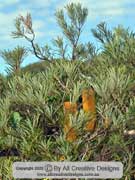
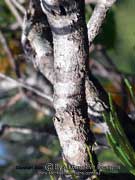
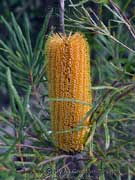
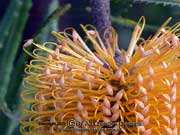
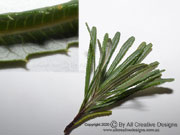
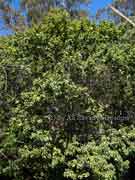
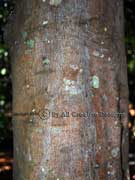
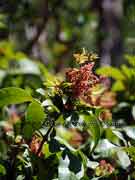
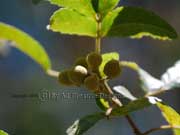
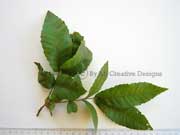
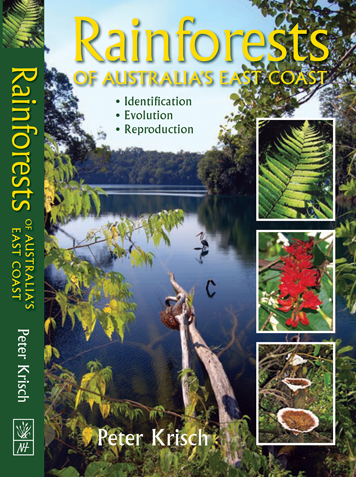
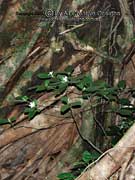
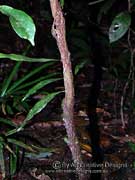
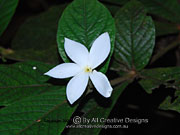
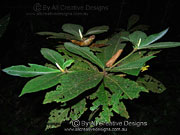
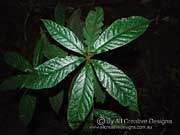
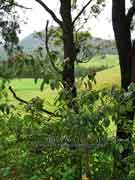
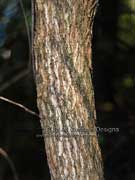
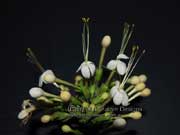
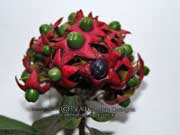
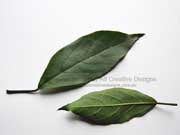
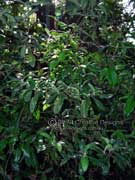
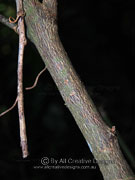
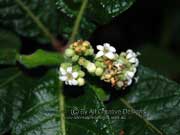
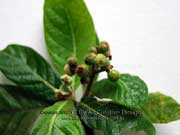
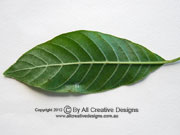
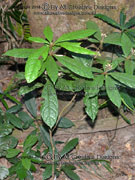
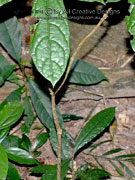
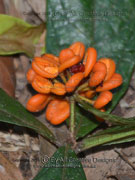
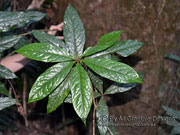
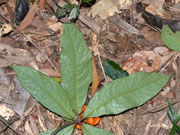
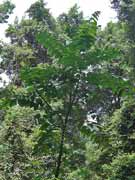
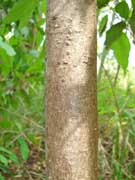
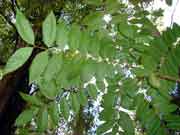
tn.jpg)
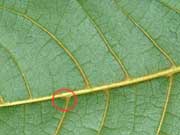
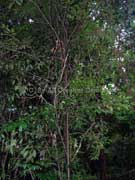
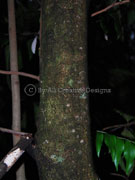
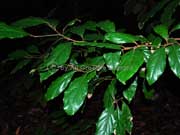
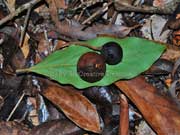
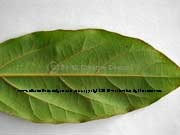
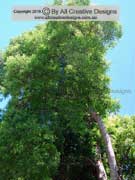
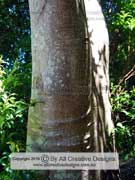
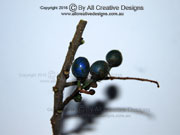
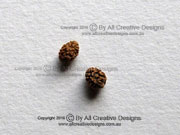
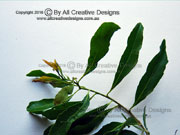
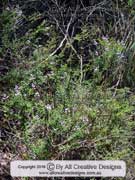
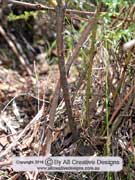
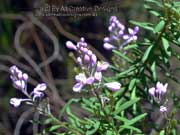
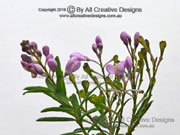
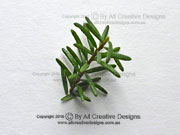
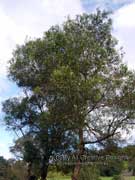
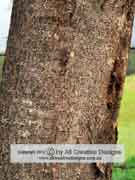
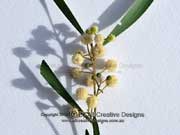
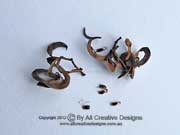
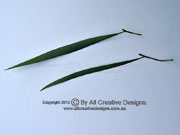
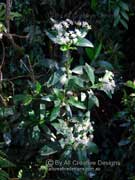
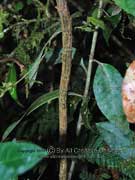
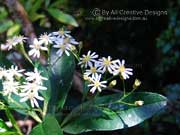
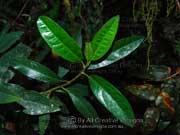
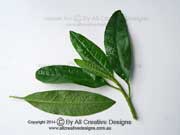
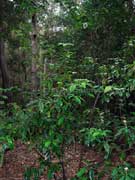
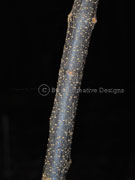
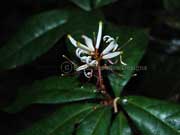
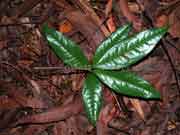
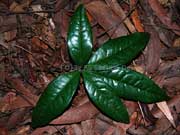
tn.jpg)
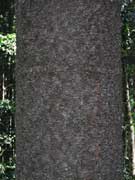
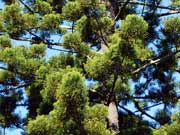
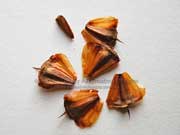
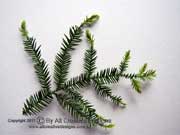
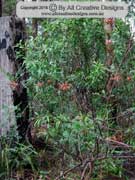
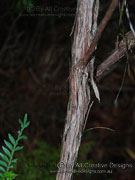
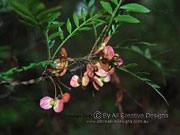
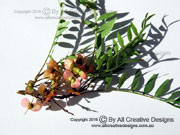
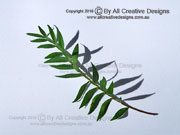
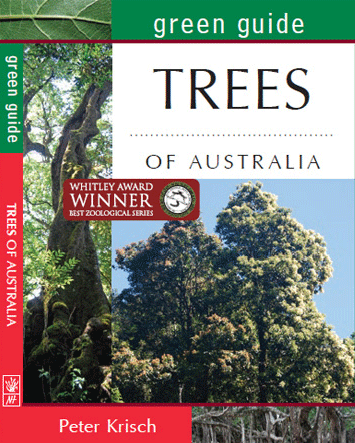
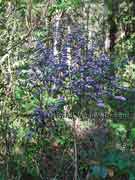
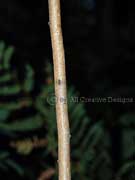
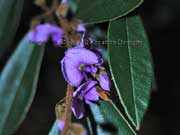
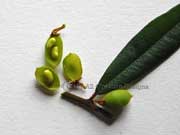
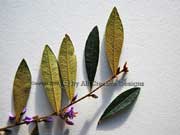
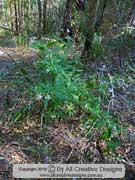
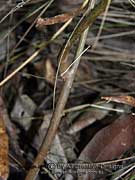
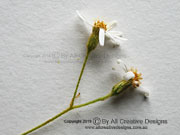
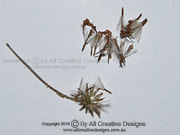
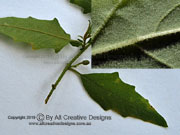
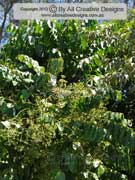
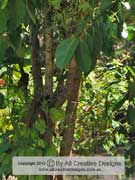
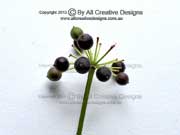
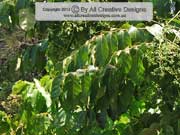
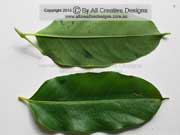
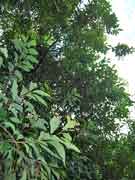
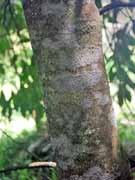
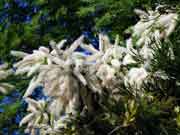
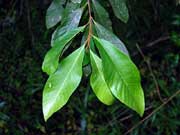
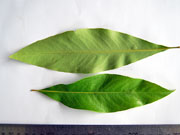
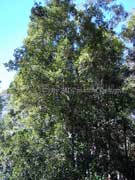
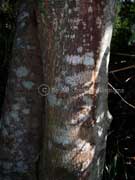
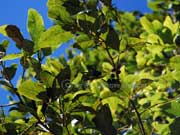
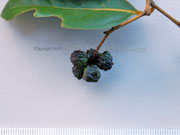
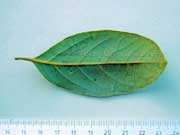
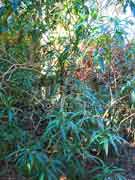
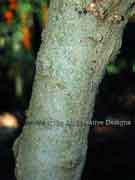
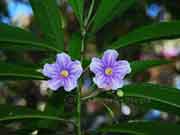
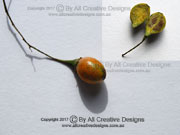
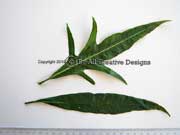
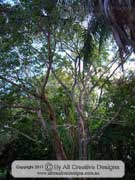
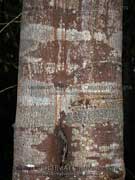
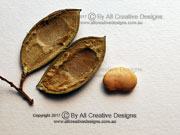
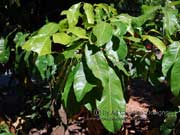
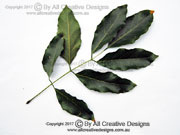
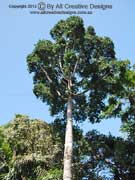
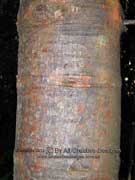
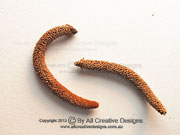
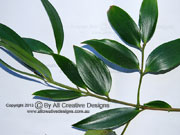
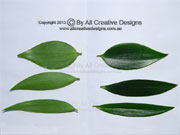
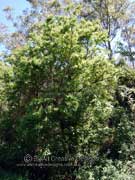
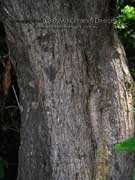
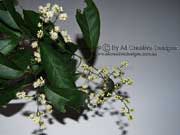
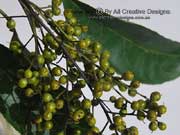
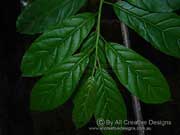
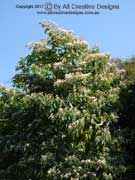
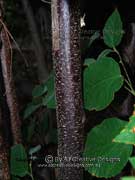
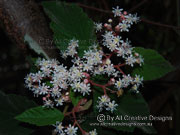
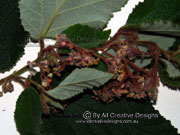
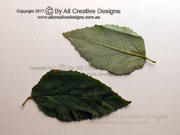
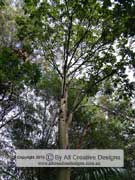
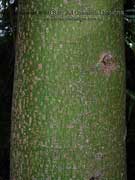
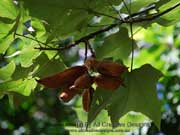
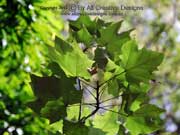
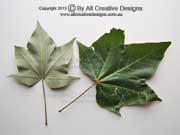
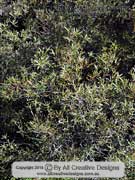
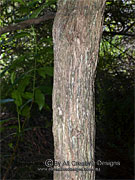
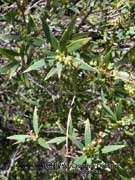
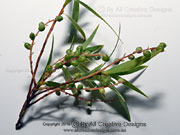
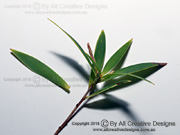
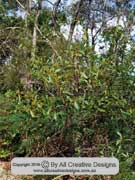
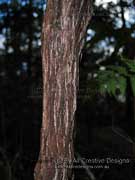
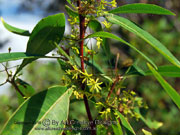
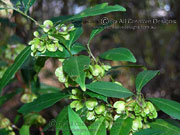
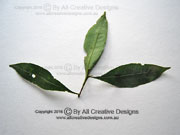
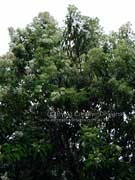
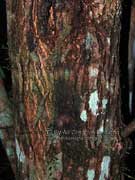
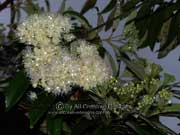
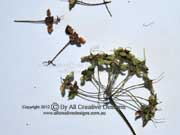
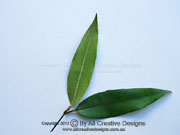
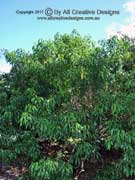
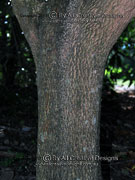
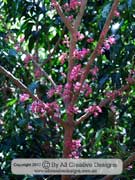
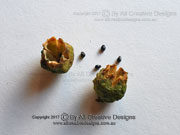
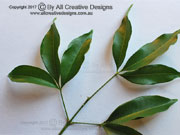
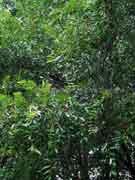
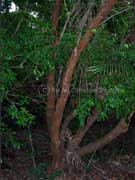
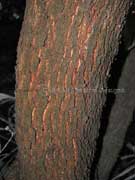
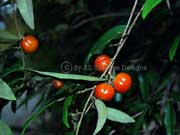
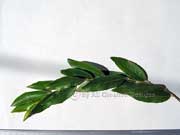
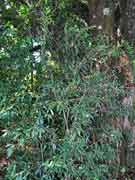
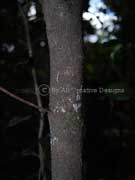
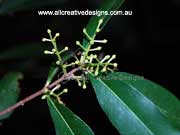
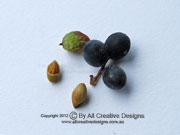
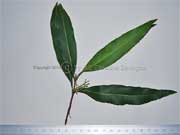
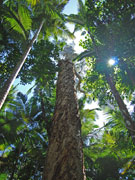
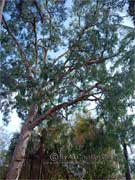
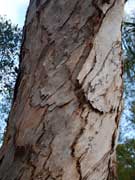
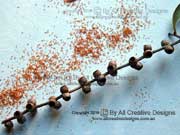
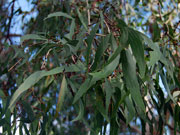
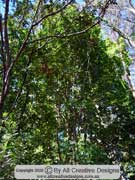
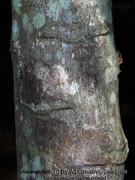
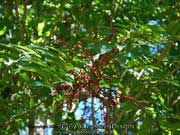
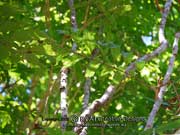
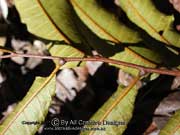
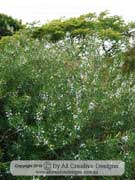
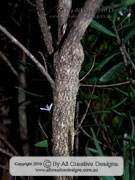
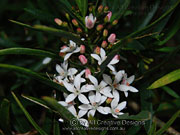
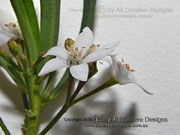
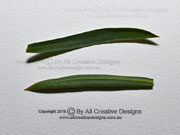
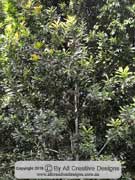
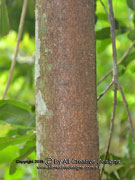
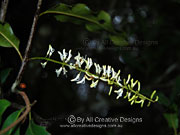
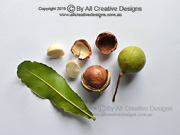
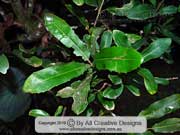
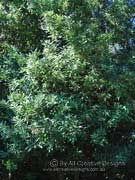
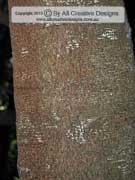
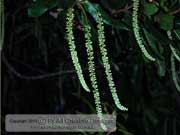
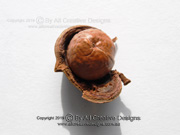
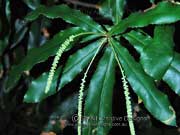
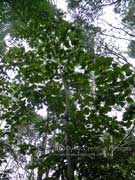
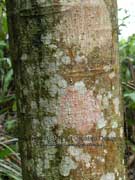
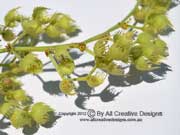
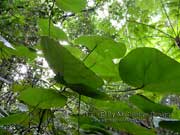
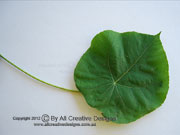
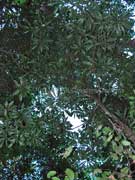
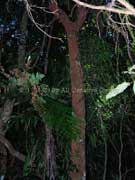
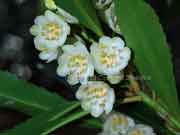
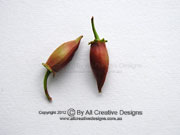
tn.jpg)
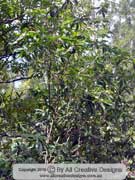
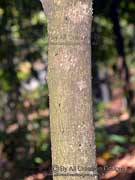
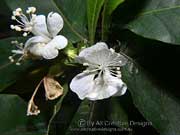
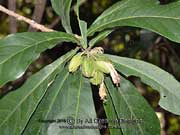
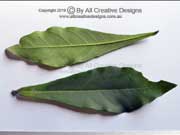
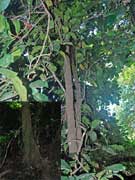
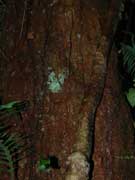
tn.jpg)
tn.jpg)
